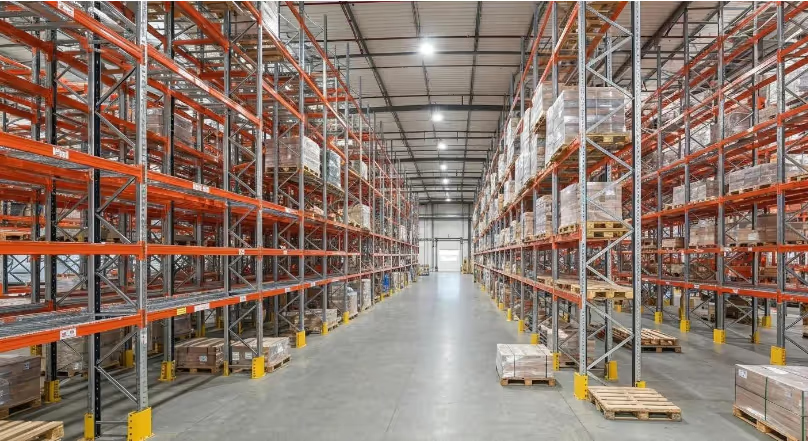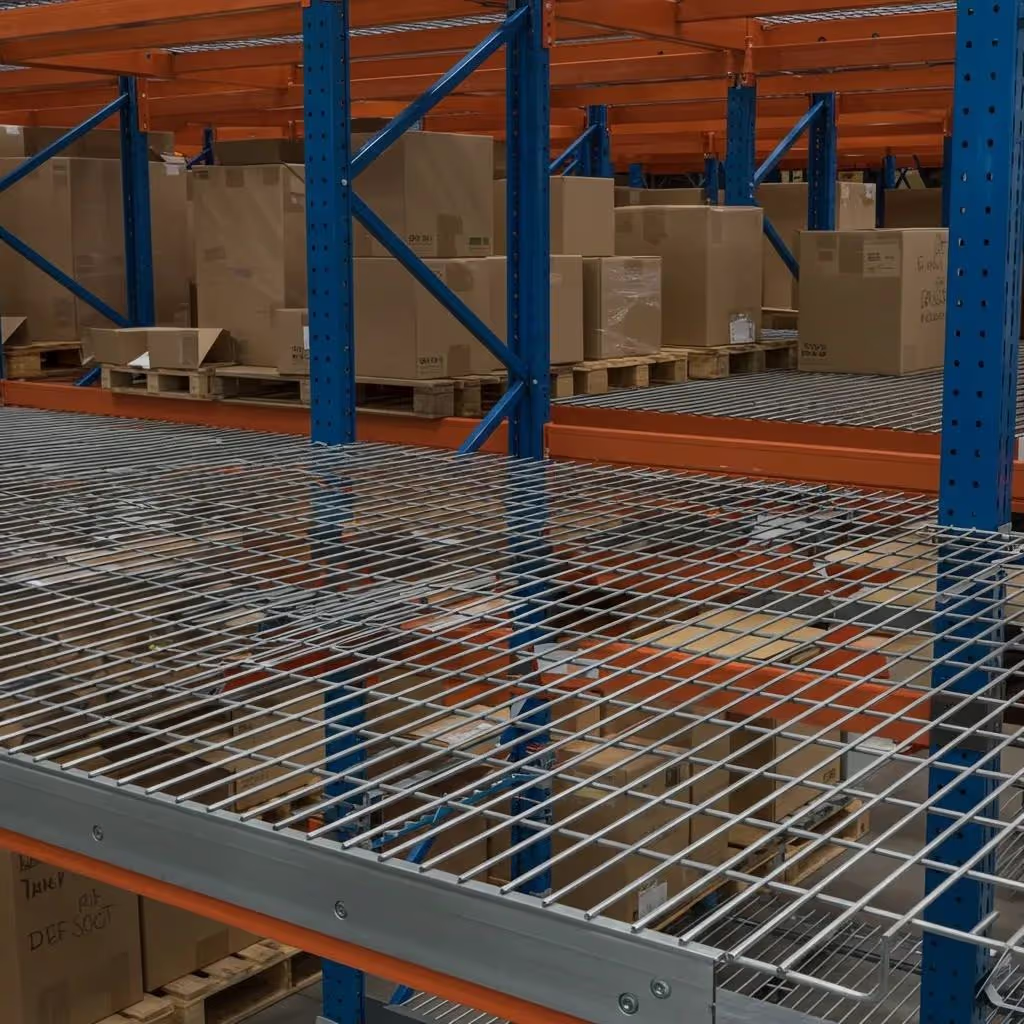
Efficient warehouse storage hinges on robust pallet racking components such as Upright Frames, Cross Beams, and Wire Decking are designed for optimal load distribution, safety, and durability. Informed by Skyteck Online’s plumbing-style precision, this guide defines each component’s function, material specifications, installation best practices, and maintenance strategies. You will learn:
- The role and variants of Upright Frames
- How Cross Beams distribute loads and connect securely
- The safety and regulatory benefits of Wire Decking
- Key safety accessories and rack protectors
- Planning, installation, and post-installation protocols
- System integration for efficiency and stability
- Maintenance routines to extend rack life
What Are Pallet Rack Upright Frames and Why Are They Essential?
Pallet rack upright frames are the vertical posts that support cross beams and decking, forming the backbone of selective racking systems. By bearing vertical loads and anchoring to the floor, upright frames ensure stability under dynamic warehouse conditions. Their primary benefit is maintaining plumb alignment and distributing weight through high-tensile steel posts.
Beyond vertical support, upright frames define bay height, aisle width, and overall rack capacity. Skyteck Online emphasizes engineered gauge steel and reinforced bracing to meet RMI safety standards. Precise anchoring prevents tipping and enhances seismic resistance, which directly contributes to operational safety and storage efficiency.
What is the function of an Upright Frame in a pallet racking system?
An upright frame provides vertical support and load transfer from pallets to the warehouse floor, ensuring the racking system remains plumb and secure under full and partial pallet loads.
What types of Upright Frames are available: Teardrop vs. Structural?
Teardrop upright frames feature stamped slots for bolt-in beams, offering quick adjustability, whereas structural uprights use welded end plates and bolt-on beams for greater load capacity and rigidity.
What are the key specifications and material properties of Upright Frames?
- Steel Gauge: 11–14 gauge high-tensile steel
- Height: 8–48 ft increments
- Load Capacity: 5,000–40,000 lbs per pair
How do you install and anchor Upright Frames safely?
- Position frames plumb with a laser level.
- Drill and epoxy anchor bolts in concrete at specified spacing.
- Tighten anchor nuts to torque specifications.
Anchoring ensures vertical loads are transferred safely and prevents frame displacement under live loads.
How to identify damage and perform repairs on Upright Frames?
Inspect for bent studs, cracked welds, and corrosion. Minor dents can be straightened; replace any frame with compromised welds. Regular inspections prevent progressive failure and maintain rack integrity.
How Do Pallet Rack Cross Beams Support Warehouse Storage?

Pallet rack cross beams span between upright frames to cradle pallets and distribute weight evenly across the structure. By engaging with upright slots or connectors, step beams, box beams, and structural beams form load-bearing shelves that resist deflection under point and distributed loads.
Cross beams play a key role in preventing pallet overhang and ensuring uniform load distribution. Skyteck Online’s beams feature integrated safety clips and roll-formed profiles to maintain beam-to-upright connections under dynamic forklift activity, boosting operational reliability.
What roles do Cross Beams play in load distribution and pallet support?
Cross beams transfer pallet weight laterally to upright frames while minimizing beam deflection to protect both product and structure under static and dynamic loads.
What are the different types of Cross Beams: Step Beam, Box Beam, and Structural?
- Step Beams: Roll-formed, lightweight, ideal for moderate loads.
- Box Beams: Welded, box-section for heavy loads and minimal deflection.
- Structural Beams: Custom fabricated I-section with highest capacity and rigidity.
How to determine Cross Beam load capacity and deflection limits?
Refer to manufacturer load tables that pair beam length with capacity and maximum deflection (L/200 or less). Always apply a 3:1 safety factor and consider live versus uniform loads.
What are the connection mechanisms and safety clips used with Cross Beams?
Beam connectors engage uprights via teardrop slots or bolt plates; spring-loaded safety clips lock beams to uprights, preventing accidental dislodgement during forklift impact.
What are the best practices for Cross Beam installation and leveling?
Install beams in matching pairs at the same slot height, verify levelness with a spirit level, and torque safety clips to manufacturer specs to maintain shelf flatness and load stability.
Why Use Wire Decking on Pallet Racks and What Are Its Benefits?

Wire decking is a mesh platform that rests on cross beams to support pallet loads, improve air circulation, and meet fire code requirements. By preventing small items from falling, wire decking enhances operator safety and protects inventory.
This decking design also allows sprinkler penetration for fire suppression, aligning with NFPA 13 standards. Skyteck Online’s wire decks feature waterfall or drop-in styles, galvanized coatings for corrosion resistance, and reinforced front ribs for extra load support.
What is Wire Decking and how does it support pallets and improve safety?
Wire decking is a steel mesh grid that evenly distributes pallet loads across beams, prevents product protrusion, and permits water from sprinklers to penetrate shelving for fire safety.
What types of Wire Decking designs exist: Waterfall vs. Drop-in?
- Waterfall Decking: Wraps over beam flanges for a secured fit.
- Drop-in Decking: Sits inside beam flanges, ideal for narrow-load aisles and retrofit applications.
What are the material specifications and fire safety compliance standards for Wire Decking?
Constructed from 4 mm wire rods, welded at intersections, with minimum 25 × 50 mm mesh spacing and hot-dip galvanization. Compliant with NFPA 13 sprinkler clearance requirements.
How to install Wire Decking correctly for optimal fit and load distribution?
Place decking so front rib engages beam lip, ensuring consistent seating across the shelf. Use full-bay coverage to prevent wire sagging under point loads.
How to maintain and replace Wire Decking for long-term durability?
Inspect for broken welds, corrosion, and deformation. Replace damaged panels promptly to restore uniform load support and fire safety performance.
What Are the Key Safety Features and Accessories for Pallet Racking Systems?
A secure racking system integrates protectors, spacers, and signage to mitigate impact damage and maintain structural integrity. Skyteck Online offers column guards, end-of-aisle protectors, row spacers, wall ties, and clear load capacity labels to support compliance and operator awareness.
How do Pallet Rack Protectors like Column Guards and End-of-Aisle protect racks?
Column guards absorb forklift impacts at rack bases, preventing frame damage. End-of-aisle protectors shield uprights at pallet flow intersections, reducing repair costs and downtime.
What roles do Row Spacers and Wall Ties play in rack stability?
Row spacers maintain consistent bay spacing and aisle width, while wall ties anchor rack rows to walls for lateral stability, especially in seismic zones.
How to use Load Capacity Signage and Labeling for compliance and safety?
Affix durable load signs at eye level on each level, indicating maximum uniformly distributed load. Clear labeling reinforces proper usage and reduces overloading risk.
How to Plan and Execute a Safe and Efficient Pallet Racking Installation?
Effective racking installation begins with site assessment, concrete floor verification, and layout planning. Skyteck Online’s installation methodology emphasizes precise measurements, anchor layout, and sequential assembly to streamline setup and minimize errors.
What pre-installation planning and site assessment steps are necessary?
Confirm floor flatness within ±5 mm over 3 m, verify clear ceiling height, plan rack location relative to aisles, and check overhead obstructions for forklift reach.
What is the step-by-step assembly process for pallet racking components?
- Lay out upright frames and anchor plates.
- Position cross beams and engage connectors.
- Install wire decking or shelving.
- Add safety accessories and label capacities.
How to ensure racks are plumb, level, and square during installation?
Use laser levels to align uprights vertically and horizontally, adjust anchor bolt torque, and measure diagonals to confirm squareness before final tightening.
What post-installation checks and safety protocols should be followed?
Conduct load tests on a pilot bay, inspect beam locks and decking seating, verify label accuracy, and schedule routine inspections per OSHA guidelines.
How Do Pallet Racking Components Integrate and Affect Warehouse Efficiency?
Upright frames, cross beams, and wire decking form an interdependent system where correct component matching maximizes load capacity and space utilization. Proper integration reduces material handling times and enhances picking accuracy by maintaining consistent shelf geometry.
Skyteck Online’s compatibility matrix aligns beam lengths, upright depths, and deck designs to prevent mismatches. This system-wide approach ensures predictable load distribution and reduces downtime from unscheduled repairs.
How do Upright Frames, Cross Beams, and Wire Decking interact within the Pallet Racking System?
Beams lock into uprights to establish shelf levels, while decking spans beams to create continuous platforms, together these parts define storage bay strength and accessibility.
What compatibility considerations exist between different component types and models?
Ensure beam end-plate dimensions match upright slot patterns (teardrop vs. hole-and-tab) and verify decking lip profiles suit beam flanges to prevent disengagement under load.
How does proper component selection improve load distribution and warehouse safety?
Selecting matched components prevents overloading, beam deflection, and unexpected failures, leading to safer operations, fewer accidents, and optimized storage density.
What Are the Best Practices for Maintaining and Extending the Life of Pallet Racking Components?
Routine inspections and timely repairs preserve rack integrity and reduce replacement costs. Skyteck Online recommends quarterly audits, damage tracking logs, and proactive part replacement to sustain operational reliability.
How to conduct regular inspections and identify common damage in components?
Use a checklist to examine uprights for straightness, beams for deflection, decking for broken welds, and anchors for looseness. Record findings and prioritize repairs.
What repair techniques and replacement guidelines ensure rack longevity?
Straighten minor dents in uprights with hydraulic presses, replace cracked beams immediately, and use OEM-spec parts. Never weld in-place; always detach and replace damaged sections.
How do environmental factors and floor conditions affect component durability?
Moisture accelerates corrosion on unprotected steel; uneven floors cause point loading and beam fatigue. Implement corrosion-resistant coatings and level floor slabs to mitigate these risks.
In-depth understanding of pallet racking components such as upright frames, cross beams, and wire decking that ensures safe, efficient warehouse storage. By following precise installation, compatibility, and maintenance protocols, operations benefit from maximized load capacity, reduced downtime, and enhanced safety. Trust Skyteck Online’s plumbing-style expertise to support your racking needs with engineered solutions and rigorous service guidance. Continuous monitoring and proactive upkeep keep your system reliable and compliant well into the future.


.svg)






